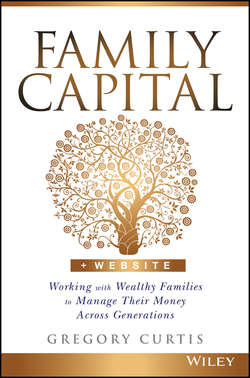Читать книгу Family Capital - Curtis Gregory - Страница 7
На сайте Литреса книга снята с продажи.
Acknowledgments
ОглавлениеThis book opens with the stock market crash of 1973–1974 and it closes with the challenges of navigating a central banker–fueled bull market in the summer of 2015. Over the course of those 41 years I've had the extraordinary good fortune to work with hundreds of remarkable American and non-American families.
In 1974, I was a young lawyer slaving away in the bowels of a very large corporate law firm, one that today is among the 25 largest law firms in the world. In those days I was utterly ignorant of the challenges faced by families of wealth, but I quickly got a baptism of fire – a stock market that, on an inflation-adjusted basis, dropped more than 50 % in less than two years.
Five years later, I joined the family office of one of America's most iconic families – the Mellons of Pittsburgh. That family had established its first family office in 1868, and so far as I know it is the oldest continually operating family office in the world.
In the mid-1980s, I organized my own firm, Greycourt, which has now served wealthy families with distinction for 30 years. My first 12 clients were all European families, an experience that very much broadened and deepened my horizons. Non-American families tend to think quite differently about the world and about their capital than do American families.
In America, stock markets have operated largely uninterrupted since the Buttonwood Agreement of 1792 – 123 years of securities trading activity. But it's important to understand how fantastically unusual that experience is. Our European cousins have seen their stock markets destroyed again and again, most recently in World War I and World War II. And even the European experience is a rock of stability compared to the calamities faced by families in Latin America, the Middle East, and elsewhere.
Private capital faces all the usual headwinds: taxes, inflation, high fees, price volatility, and human error. But, in addition, it must withstand war, revolution, financial panic, global depression, expropriation, and terrorist attack. It's no mystery why shirtsleeves-to-shirtsleeves in three generations is the norm. What is remarkable is how many families escape this trap and remain not just wealthy but vibrant and happy into their eighth generation and beyond.
To have the opportunity to work with such families and to generate deep and lasting friendships with many of them has been one of the genuine pleasures of my life. This book could not have been written without those families. I wish I could name them all and specify from which I learned this lesson and from which I learned that. But one of the first lessons of the wealth advisory world is that confidentiality is paramount. Still, they know who they are and I hope they know how much they have taught me.
Aside from the families, I've been privileged to work for nearly 30 years with a remarkable group of people at Greycourt. Turnover at the firm has been so extraordinarily low that almost everyone who joined the firm either is still with us or has retired.
I should thank every one of the employees at Greycourt, but in the interests of time and space let me single out my fellow managing directors: Greg Friedman, CEO; Jim Foster, CIO; Mark Laskow; David Lovejoy; Roy Nichol; and Matt Litwin. Gretchen Shoup, our COO, and Jamie Linhart, who oversees performance reporting. Liz Jones, whose client service operation has freed up our time to deal with larger issues. The Administration Group (and my own assistant, Dana Schmitt), who keep the trains running on time. Chris Fineburg and Tom Moore, who handle much of the day-to-day work on so many of my clients. Jeff Moyer, manager of the Greycourt Partners Fund, which handles my own capital. Chad Cribbs, Stephanie Halpern, and Brian LaBore in manager research.
In a very real sense, it is the families and my colleagues at Greycourt who have provided the material for this book. I've merely been the scrivener. Thanks to one and all.
GC
August 3, 2015
